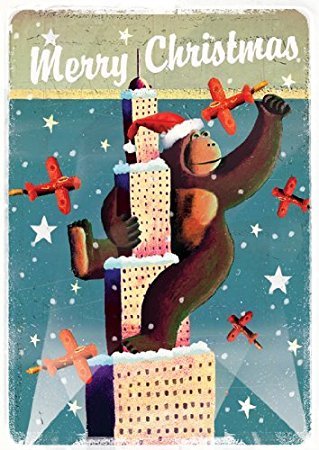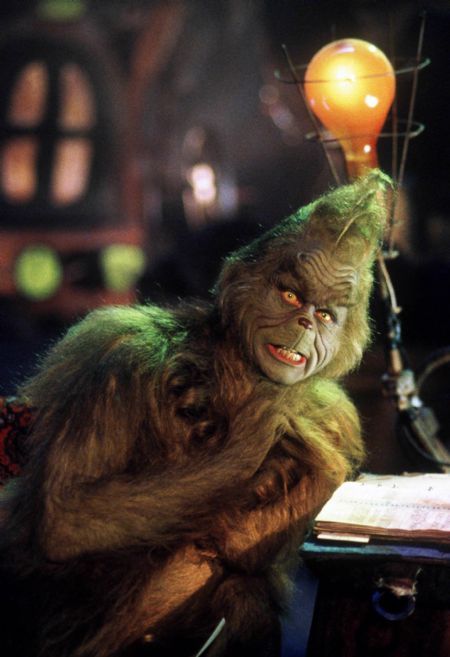#once jason figured out that larry david is really like that in person his character fit better
Photo






BIGFOOT JOINS THE RANKS OF AMERICAN CHRISTMAS ICONS
When did Bigfoot become a Christmas icon? I’m sure that question sounds strange to most of you, but I can’t be the only one to have noticed Sasquatch’s gradual induction into the pantheon of modern American Christmas characters. Right now you can buy Bigfoot Christmas tree ornaments, sweaters and stockings online, while a retailer as mainstream as Wal-Mart currently has a pair of yuletide Yeti shirts for sale in stores. If you need more proof just pull up Netflix and check out the new film Pottersville (2017, Dir. Seth Henrikson); an indy Christmas comedy with some major league talent including Michael Shannon (The Shape of Water), Judy Greer (Jurassic World), Ron Perlman (Pacific Rim) and Ian McShane (American Gods) – the latter doing his best impression of Robert Shaw’s character from Jaws (1975, Dir. Steven Spielberg). The film revolves around the small town of Pottersville – from the Christmas classic It’s A Wonderful Life (1946, Dir. Frank Capra) – which has fallen on hard times economically. The residents gets an unexpected Christmas gift however in the form of a series of Bigfoot sightings which instantly transforms their forgotten hamlet into a must-visit tourist attraction!
Naturally, some people will scoff at the idea of Bigfoot becoming a part of the American Christmas holiday, but personally I’m all for it. I’m a big fan of Christmas monsters, ghosts and goblins – all of which were a part of the season long before Frosty the Snowman and Elf on the Shelf came along and something which I spoke about at length with John W. Morehead of Theofantastique last year. But still, the question persists, when exactly did Bigfoot get in on the holiday scene – or has he always been here?
When looking for Bigfoot’s entry point into the Christmas season the most obvious starting place is Rankin/Bass Productions’ 1964 holiday classic Rudolph the Red-Nosed Reindeer (Dir. Larry Roemer & Kizo Nagashima) featuring stop-motion by underappreciated Japanese animator Tadahito Mochinaga. As anyone who has experienced this timeless piece of Christmas Americana knows, Rudolph and his friends spend much of the movie being menaced by a giant Yeti referred to by the various characters as either the Abominable Snow Monster of the North or just the Bumble for short. Perhaps the only true Christmas kaijū, scholar Jason Barr sees the Bumble as one of the many thematic descendants of King Kong, which corroborates author David Coleman’s observation, as found in his encyclopedic The Bigfoot Filmography (2011), that no single film has had more impact on the pop-culture perception of Bigfoot and the Yeti then King Kong (1933, Dir. Merian C. Cooper & Ernest B. Schoedsack).
Of course, King Kong is a work of paleo-fiction, specifically the ‘Lost World’ sub-genre and as a result retains elements of the colonialist worldview which gave rise to the literary and cinematic tradition of stories concerning white explorers traveling to distant exotic lands where – unlike back home – “time stands still” and primitive beasts and people exist in Eden-like bliss; or at least until our intrepid adventures decide it’s their god given right to run roughshod over the place killing and/or capturing the animals and conquering the indigenous inhabitants.
As Barr writes in his book The Kaijū Film (2016), Rudolph’s Bumble is no exception to this tradition as we see the fearsome Snowman “is not only outwitted by the gathered cast” but also reduced to literal “toothless subservience” and subsequently put “to work decorating Christmas trees” in Santa’s workshop. Truly a sad fate for any once ferocious Christmas monster.
But in more recent years the Bumble’s kith and kin appear to be getting their revenge!
This leads us to our second possible point of origin for the modern Christmas Bigfoot; researcher Phyllis Siefker’s 1997 tome Santa Claus, Last of the Wild Men. Here Siefker challenges the conventional notion that America’s Santa Claus is merely a modified version of Europe’s St. Nicholas. After all, asks Siefker, why would Protestant immigrants to the New World bring with them the tradition of an extremely popular Catholic saint? As an alternative explanation Siefker proposes that Santa – with his great beard, furry coat, and habit of nocturnal prowling – is really based upon the ancient pre-Christian figure of the Wildman as outlined in such excellent scholarly works as Richard Bernheimer’s Wild Men in the Middle Ages (1952) and Roger Bartra’s Wild Men in the Looking Glass: The Mythic Origins of the European Otherness (1994).
The idea that Santa isn’t actually a “right jolly old elf” and instead a hairy, savage Bigfoot-like monster must have been at least part of Finnish filmmaker Jalmari Helander’s inspiration for his fantastically bizarre 2010 film Rare Exports: A Christmas Tale in which plucky child protagonist Pietari discovers that “the Coca- Cola Santa is just a hoax” while the actual Kris Kringle is a Kong-sized goat-horned monster who “tears naughty kids to pieces” until “not even their skeletons are left.” Unfortunately for Pietari and his friends, a rich oil tycoon from America – possibly inspired by real-life American oil tycoon Tom Slick (d. 1962) who spent much of his fortune hunting for Bigfoot and the Yeti – has come to unseal the tomb buried beneath the Korvatunturi mountain range where the Saami people imprisoned Santa long ago.
Of course for cryptozoologists like Loren Coleman who entertain the possibility that there might be some truth behind such worldwide Wildman tales, Siefker’s work represents more than just a radical rewriting of Christmastime folklore, but rather the tantalizing – though unlikely - possibility that a character as iconic and beloved as Santa Claus may have been inspired by a relic population of anomalous-primates!
More recently a different kind of yuletide Wildman has been making his presence known here in the US. This, of course, is the Krampus; a kind of shaggy demon with curled goat horns, a lolling red tongue and a talent for punishing naughty children with switches and chains. As outlined in Al Ridenour’s excellent The Krampus and the Old, Dark Christmas (2016), Krampus hails from Austria where in small remote mountains towns such as Bad Gastein and Öblarn the day preceding the Catholic Church’s feast in honor of St. Nicolas sees the celebration of Krampusnacht (“Krampus Night”) in which children of all ages anticipate a visit from St. Nicholas and his posse of Krampus. These house visits are enacted by local Krampuspass (“Krampus Troupes”) composed of men ranging in age from their late teens to early forties who prepare all-year by sewing heavy wool suits made from sheep and goat’s hair and carving handcrafted wooden masks – called klaubaufkopfe (“Krampus heads”) – which along with chains, bells, switches and baskets will be worn by the performers as they accompany St. Nick – typically played by the tallest member of a troupe – throughout the town to distribute rewards and punishments. In addition to these house visits many towns also feature a Krampusumzüge (“Krampus-Run”) in which dozens of individuals dressed as the Krampus run through the streets threatening and menacing children as well as occasionally smacking a pretty young girl on the rear with their switches all while consuming copious amounts of alcohol. All of this makes for a festival that is equal parts Christmas, Halloween and Mardi Gras.
Since the early 2000s Krampus has begun an unassailable assent through mainstream American pop-culture gradually, and now undeniably, situating himself among other time honored holiday icons. According to reporter Christopher Bickel as of 2014 there are annual Krampus runs, bar crawls, parties and other related events being help in over thirty US cities nationwide while Krampus’ likeness can be found on a huge number of products including Christmas sweaters, stockings, ornaments, playing cards, plush and vinyl toys, decorative figurines, t-shirts, books, comics and in cartoons ranging from Scooby-Doo to American Dad. In 2015 Hollywood unleashed two theatrical Krampus flicks with the William Shatner staring anthology A Christmas Horror Story (Dir. Grant Harvey, Steven Hoban & Brett Sullivan) and Legendary/Universal Pictures’ Krampus (Dir. Michael Dougherty). There’s even a company selling an 11-foot-tall animatronic toddler swinging Krampus which you can put in your front yard!
Krampus may also have played a part in inspiring another popular 20th-Century American Christmas monster: The Grinch. As artist Jeffrey Vallance – who via several essays has picked up the torch lit by Phyllis Siefker and continued exploring the possibility of Santa’s Wildman roots – has observed: “Over the ages, the brutal Wildman figure evolved into a character more like a clown or holiday fool. How the Grinch Stole Christmas by Dr. Seuss follows a classic Wildman scenario: The Grinch is a hairy, Bigfoot-like creature that lives in an alpine cave in a mountain similar to the Matterhorn.”
While Theodor Geisel – aka Dr. Seuss – maintained that The Grinch was primarily an autobiographical character, considering the beloved children’s author’s German ancestry one cannot help but wonder if yuletide Wildman characters like Krampus didn’t also play some part in the formation of the beloved holiday humbug.
Back in November I delivered a presentation at the American Academy of Religions in Boston on the Krampus in which I argued that American’s recent infatuation with the Krampus – and other Christmas monsters, including apparently now Bigfoot – can best be understood as an oppositional response to conservative’s alleged “War on Christmas,” a moment perhaps best embodied by comedian Stephen Colbert’s 2009 declaration that Americans “need to bring Krampus to America to fight the War on Christmas.” While it seems clear that many Americans who desired a more interfaith approach to the season did not initially see themselves as engaged in a “War” the continual insistence by certain factions – and Fox News host Bill O’Reilly in particular – that there was indeed one eventually drove those opposed to a totalitarian Protestant interpretation of the holiday to fight back and call in the cavalry in the form of a monstrous menagerie of older darker Christmas creations. As scholar Joseph P. Laycock has observed monsters are often underappreciated sources of religious meaning, a set of symbols and rituals which can be used to inspire awe in the beholder, be it participating in a Krampusumzüge or catching a brief glimpse of Bigfoot.
#christmas#king kong#krampus#grinch#rare exports#bigfoot#yeti#rudolph the red nosed reindeer#bumble#sasquatch#santa claus#wildman#cryptozoology#pottersville
13 notes
·
View notes